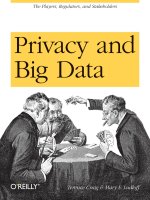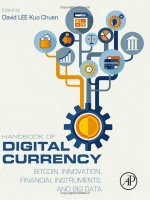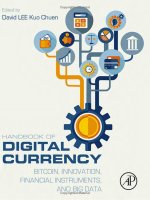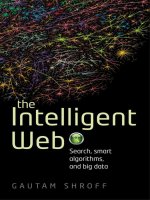courser web intelligence and big data 8 predict lecture slides
Bạn đang xem bản rút gọn của tài liệu. Xem và tải ngay bản đầy đủ của tài liệu tại đây (3.8 MB, 15 trang )
Predict
bo+om-‐up
predic0on
………
learning,
least-‐squares
and
func0on
approxima0on
………….
predic0on,
op0miza0on
and
control
…………………
hierarchical
temporal
memory:
predic0on
……………………….
top-‐down/bo+om-‐up
blackboard
architecture
…………………………….
web-‐intelligence;
brains;
adap0ve
BI
………………………………….
challenge
problems
learning
and
predic0on
m
data
points
each
having
(i)
features
x1
…
xn-‐1
=
x
and
(ii)
output
variable(s)
y1
..
yk.
e.g.
prices
(numbers
for
Y);
xi
can
be
numbers
or
categories
for
now
assume
k=1,
i.e.
just
one
output
variable
y
linear
predic,on:
f(x)
=
E[y|x]
also
minimizes*:
1
ε
=
E[error]=
E[y-‐f(x)]2
≈
m
Σm(yi-‐f(xi))2
suppose
f(x)
=
[x;1]Tf
=
x’Tf
i.e.
linear
in
x;
so
we
want
X
f
≈
y
Σm(yi
-‐
x’iTf)2
=
(X
f
-‐
y)T
(X
f
-‐
y)
minimized
if
deriva0ve
=
0,
i.e.
XTX
f
–
XTy
..
“normal
equa0ons”
once
we
have
f,
our
“least-‐squares”
es0mate
of
y|x
is
f
LS(x)
=
x’Tf
x'
1T
T
x'
i
X:
m
x
n
X
TX
n
x
n
f
n
≈
1
f
1
=
XTy
n
x
1
y
m
x
1
some
examples
x
y
10
1.2
22
1.8
42
4.6
15
1.3
X
f
y
≈
∑( f x − y )
≡ 1−
∑(y − y )
T
i
how
good
is
the
‘fit’
?
R2
2
i
i
2
=
.95
i
i
example
2*:
[y,
x]
=
[wine-‐quality,
winter-‐rainfall,
avg-‐temp,
harvest-‐rainfall]
f
LS(x)
=
12.145
+
0.00117
×
winter-‐rainfall
+
0.0614
×
avg-‐
temperature
−
0.00386
×
harvest
rainfall
*Super-‐crunchers,
Ian
Aryes
2007:
Orley
Ashenfelter
beyond
least-‐squares
categorical
data
logis0c
regression
support-‐vector-‐machines
f (x) = 1− 1
f(x)
e
− fTx
complex
f
:
‘kernel’-‐parameters
also
learned
neural
networks
linear
=
least-‐squares
non-‐linear
like
logis0c
etc.
f(x)
f(x)
.00117
.0614
-‐.00386
12.145
feed-‐forward,
mul0-‐layer
more
complex
f
feed-‐back
like
a
belief
n/w;
“explaining-‐away”
effect
winter
rainfall
average
temp.
harvest
hidden-‐layer
1
rainfall
deep-‐belief
network
learning
parameters
whatever
be
the
model:
need
to
minimize
|f(x)
–
y|=
ε(f)
complex
f
=>
no
formula
so,
itera0ve
method
;
start
with
f0
related
ma+ers
“best”
solu0on
w:
maximize
φ(w)
control
ac0ons:
θi:
si+1=S(θi)
works
fine
with
numbers,
i.e.
x
in
Rn
minimize
|s
-‐
Ξ|
f1
=
f0
+
δf
f
i+1
=
f
i
−
α
∇
f
ε
(
f
i
)
gradient-‐descent
use
ε(fi)-‐ε(fi-‐1)
to
approximate
deriva0ve
..
caveats:
local
minima,
constraints
for
categorical
data:
convert
to
binary,
i.e.
{0,1}N
“fuzzyfica0on”:
convert
to
Rn
neighborhood-‐search;
heuris0c
search,
gene0c
algorithms
..
probabilis0c
models,
i.e.
deal
with
probabili0es
instead
predict
–
decide
-‐
control
robo-‐soccer
predict
where
the
ball
will
be;
decide
best
path;
navigate
there
predict
how
other
players
will
move
self-‐driving
cars
predict
the
path
of
a
pedestrian;
decide
path
to
avoid;
steer
car
predict
traffic;
decide
all
op0mal
routes
to
des0na0on
energy-‐grid
predict
energy
demand;
decide
&
control
distribu0on
predict
supply
by
‘green-‐ness’;
adjust
prices
op:mally
supply-‐chain
predict
demand
for
products;
decide
best
produc0on
plan;
execute
it
detect
poten0al
risk
&
evaluate
impact;
re-‐plan
produc0on;
execute
it
marke:ng
predict
demand;
decide
promo0on
strategy
by
region;
execute
it
classifica0on
predic0on
which
learning/predic0on
technique?
features
(i.e.
X)
target
(i.e,
Y)
correla,on
technique
numerical
numerical
linear
regression
categorical
numerical
numerical
numerical
unstable
/
severely
non-‐
linear
neural-‐networks
(mul0-‐level,
hidden-‐layers,
non-‐linear)
numerical
categorical
stable
/
linear
logis,c
regression
numerical
categorical
unstable
/
severely
non-‐
linear
support-‐vector
machines
(SVM)
stable
/
linear
linear-‐regression
neural-‐networks
SVM
categorical
categorical
(feature
coding)
(feature-‐coding)
Naïve
Bayes
and
other
Probabilis0c
Graphical
Models
hierarchical
temporal
memory
extracted
from
Jeff
Hawkins’s
ISCA
2012
charts
sparse
distributed
representa0ons
remember
the
proper0es
of
{0,1}1000:
very
low
chance
that
pa+erns
differ
in
less
than
450
places
forced
sparse
pa+ern:
e.g.
2000
bits
with
only
40
1s
very
low
chance
of
a
random
sparse
pa+ern
matching
any
1s
even
if
we
drop
all
but
10
random
posi0ons;
another
sparse
pa+ern
matching
some
of
these
10
is
most
likely
another
instance
of
the
same
sparse
40
1s
pa+ern
(sub-‐sampled
differently)
similar
‘scene’
will
give
similar
sparse
pa+ern
even
a}er
sub-‐sampling
Jeff
Hawkins’s
ISCA
2012
sequence
learning
each
cell
tracks
the
previous
configura0on
–
again
sparsely;
via
‘synapse
connec0ons;
these
form
and
are
forgo+en
or
reinforced
if
predicted
value
occurs
column
per
cell
–
predicts
further
ahead
Jeff
Hawkins’s
ISCA
2012
hierarchy;
linkages;
applica0ons
mul0ple
‘regions’
in
a
hierarchy
bo+om-‐up
(feed-‐forward)
plus
top-‐down
(feed-‐back)
mathema0cally
HTM
is
≈
deep
belief
network
applica0ons:
Jeff
Hawkins’s
ISCA
2012
something
missing?
“predict
how
other
players/pedestrians
will
move”
“`predict’
the
consequences
of
a
decision”:
what-‐if?
-‐ use
these
‘predic0ons’
to
re-‐evaluate
/
re-‐look
at
inputs
and
re-‐plan
missing
element:
symbolic
reasoning,
op0miza0on
etc.
can
they
work
together:
`blackboard’
architecture
examples:
-‐
speech
-‐
analogy
knowledge
Sources:
feature-‐learning
clustering
sequence-‐miners
classifiers
rule-‐engines
decision-‐engines
hierarchical
Bayesian…
what
does
data
have
to
do
with
intelligence?
“any
fool
can
know
…
the
point
is
to
understand.”
-‐
Albert
Einstein
and
…
the
goal
of
understanding
is
to
predict
Listen
Predict
recap
and
challenges
NB
classifier;
informa0on
search
hashing
memory
Listen
op0miza0on
next
0me?
Predict
linear
predic0on,
neural
net,
HTM,
blackboard
Load
clustering,
rule
mining
latent
models
reasoning,
seman0c
web
Bayesian
networks
map-‐reduce
database
evolu0on
all
remaining
Quiz/HW/assignment
due
9th
Nov
23:59
PST
Final
Exam
on
Friday
Nov
9th
…
IST
un0l
23:59
PST
(albeit
a
short
break
to
extract
IIT/IIT
scores)
THANKS
FOR
BEING
SUCH
A
GREAT
CLASS!
please
review
on:
www.coursetalk.org









